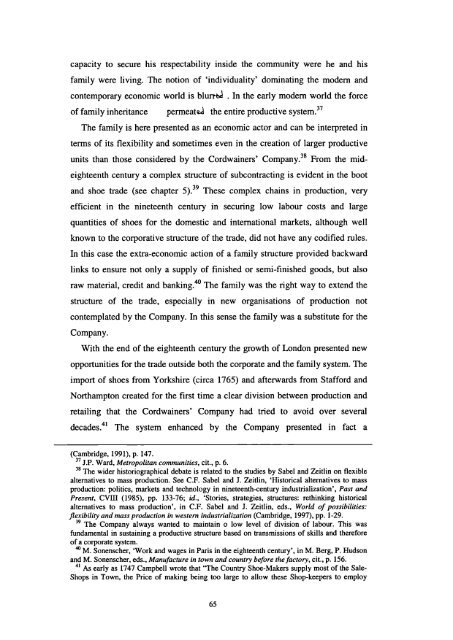The Boot and Shoe Trades in London and Paris in the Long Eighteenth Century
The Boot and Shoe Trades in London and Paris in the Long Eighteenth Century
The Boot and Shoe Trades in London and Paris in the Long Eighteenth Century
You also want an ePaper? Increase the reach of your titles
YUMPU automatically turns print PDFs into web optimized ePapers that Google loves.
capacity to secure his respectability <strong>in</strong>side <strong>the</strong> community were he <strong>and</strong> his<br />
family were liv<strong>in</strong>g. <strong>The</strong> notion of '<strong>in</strong>dividuality' dom<strong>in</strong>at<strong>in</strong>g <strong>the</strong> modern <strong>and</strong><br />
contemporary economic world is blurr . In <strong>the</strong> early modern world <strong>the</strong> force<br />
of family <strong>in</strong>heritance permeaft <strong>the</strong> entire productive system.37<br />
<strong>The</strong> family is here presented as an economic actor <strong>and</strong> can be <strong>in</strong>terpreted <strong>in</strong><br />
terms of its flexibility <strong>and</strong> sometimes even <strong>in</strong> <strong>the</strong> creation of larger productive<br />
units than those considered by <strong>the</strong> Cordwa<strong>in</strong>ers' Company. 38 From <strong>the</strong> mid-<br />
eighteenth century a complex structure of subcontract<strong>in</strong>g is evident <strong>in</strong> <strong>the</strong> boot<br />
<strong>and</strong> shoe trade (see chapter 5)39 <strong>The</strong>se complex cha<strong>in</strong>s <strong>in</strong> production, very<br />
efficient <strong>in</strong> <strong>the</strong> n<strong>in</strong>eteenth century <strong>in</strong> secur<strong>in</strong>g low labour costs <strong>and</strong> large<br />
quantities of shoes for <strong>the</strong> domestic <strong>and</strong> <strong>in</strong>ternational markets, although well<br />
known to <strong>the</strong> corporative structure of <strong>the</strong> trade, did not have any codified rules.<br />
In this case <strong>the</strong> extra-economic action of a family structure provided backward<br />
l<strong>in</strong>ks to ensure not only a supply of f<strong>in</strong>ished or semi-f<strong>in</strong>ished goods, but also<br />
raw material, credit <strong>and</strong> bank<strong>in</strong>g. 4° <strong>The</strong> family was <strong>the</strong> right way to extend <strong>the</strong><br />
structure of <strong>the</strong> trade, especially <strong>in</strong> new organisations of production not<br />
contemplated by <strong>the</strong> Company. In this sense <strong>the</strong> family was a substitute for <strong>the</strong><br />
Company.<br />
With <strong>the</strong> end of <strong>the</strong> eighteenth century <strong>the</strong> growth of <strong>London</strong> presented new<br />
opportunities for <strong>the</strong> trade outside both <strong>the</strong> corporate <strong>and</strong> <strong>the</strong> family system. <strong>The</strong><br />
import of shoes from Yorkshire (circa 1765) <strong>and</strong> afterwards from Stafford <strong>and</strong><br />
Northampton created for <strong>the</strong> first time a clear division between production <strong>and</strong><br />
retail<strong>in</strong>g that <strong>the</strong> Cordwa<strong>in</strong>ers' Company had tried to avoid over several<br />
decades. 4' <strong>The</strong> system enhanced by <strong>the</strong> Company presented <strong>in</strong> fact a<br />
(Cambridge, 1991), P. 147.<br />
37 J.P. Ward, Metropolitan communities, cit., p. 6.<br />
38 <strong>The</strong> wider historiographical debate is related to <strong>the</strong> studies by Sabel <strong>and</strong> Zeitl<strong>in</strong> on flexible<br />
alternatives to mass production. See C.F. Sabel <strong>and</strong> J. Zeitl<strong>in</strong>, 'Historical alternatives to mass<br />
production: politics, markets <strong>and</strong> technology <strong>in</strong> n<strong>in</strong>eteenth-century <strong>in</strong>dustrialization', Past <strong>and</strong><br />
Present, CVIII (1985), pp. 133-76; id., 'Stories, strategies, structures: reth<strong>in</strong>k<strong>in</strong>g historical<br />
alternatives to mass production', <strong>in</strong> C.F. Sabel <strong>and</strong> J. Zeitl<strong>in</strong>, eds., World of possibilities:<br />
flexibility <strong>and</strong> mass production <strong>in</strong> western <strong>in</strong>dustrialization (Cambridge, 1997), pp. 1-29.<br />
<strong>The</strong> Company always wanted to ma<strong>in</strong>ta<strong>in</strong> o low level of division of labour. This was<br />
fundamental <strong>in</strong> susta<strong>in</strong><strong>in</strong>g a productive structure based on transmissions of skills <strong>and</strong> <strong>the</strong>refore<br />
of a corporate system.<br />
° M. Sonenscher, 'Work <strong>and</strong> wages <strong>in</strong> <strong>Paris</strong> <strong>in</strong> <strong>the</strong> eighteenth century', <strong>in</strong> M. Berg, P. Hudson<br />
<strong>and</strong> M. Sonenscher, eds., Manufacture <strong>in</strong> town <strong>and</strong> country before <strong>the</strong> factory, cit., p. 156.<br />
As early as 1747 Campbell wrote that "<strong>The</strong> Country <strong>Shoe</strong>-Makers supply most of <strong>the</strong> Sale-<br />
Shops <strong>in</strong> Town, <strong>the</strong> Price of mak<strong>in</strong>g be<strong>in</strong>g too large to allow <strong>the</strong>se Shop-keepers to employ<br />
65


